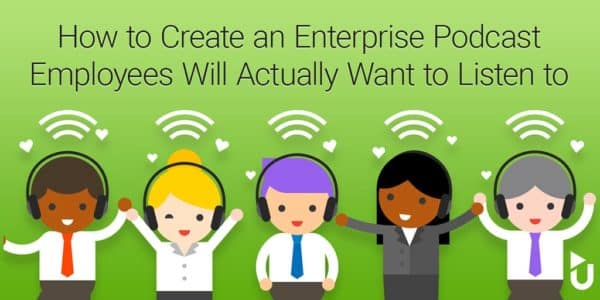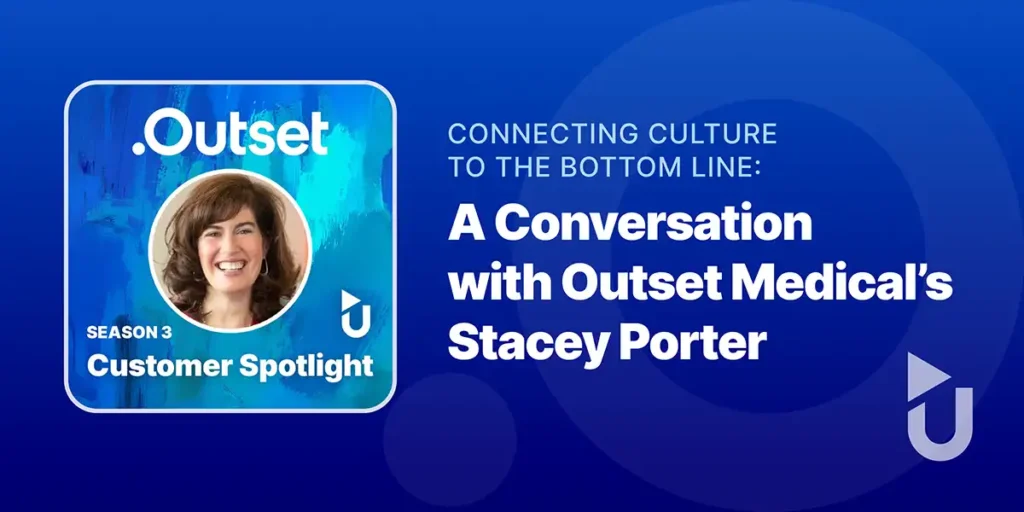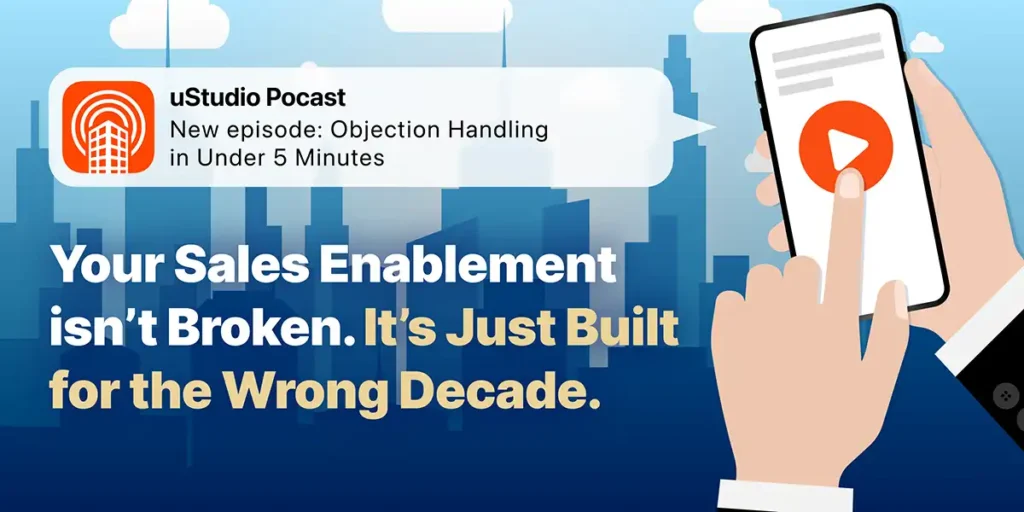How to Leverage Enterprise Podcast Solutions to Create Podcasts Employees Will Want to Listen to
Jackie Logan | Podcasting

Introduction to Enterprise Podcast Solutions
Podcasting adoption continues to grow steadily. According to Statista, 44% of Americans have consumed a podcast in the past month, up from 39% in 2019. That growth indicates a consumer desire to consume content in new ways, and it can be a boon for your company’s internal comms program. That’s where enterprise podcast solutions come in.
What Is an Enterprise Podcast Solution and How Does It Help with Creating Internal Podcasts?
An enterprise podcast solution is a secure, private podcasting platform designed specifically for organizations to create, manage, and distribute internal podcasts. Unlike public podcasting platforms, these private podcast solutions offer advanced security features such as user authentication, access controls, and content encryption to ensure that sensitive information is protected.
These platforms are built with the unique needs of businesses in mind, allowing them to share confidential updates, training materials, executive communications, and more with specific audiences within the organization. With a corporate streaming network, companies can control who can access each episode, monitor engagement, and gain insights into how employees are interacting with the content.
Using a secure enterprise podcast solution, rather than a public podcasting platform, is essential for organizations that prioritize data privacy, security, and control. Public platforms lack the necessary protections for confidential or proprietary information, which means that content could be accessed by unintended audiences or even competitors.
In contrast, enterprise podcast solutions are tailored for internal communications, providing businesses with the tools to create engaging, accessible, and secure content without risking data exposure. Additionally, these platforms offer valuable analytics that allow companies to track listener engagement, measure the effectiveness of their content, and make improvements based on employee feedback—all in a safe and private environment.
Why Companies Are Jumping on the Enterprise Podcast Bandwagon
Let’s face it. It’s hard to reach people these days, even your own employees. Between endless emails, meetings, PDFs and slide decks, employees can’t keep up. In fact, Forbes reports up to 71% of employees admit they don’t read company emails. And you worked so hard to create them!
More businesses are looking at versatile enterprise podcast solutions to train employees, share company updates, and maintain ongoing education. Why? People are used to podcasts and enjoy them in their downtime and in-between time, capturing an attentive audience that can often be hard to attract.
Give Them What They Want
Employees appreciate corporate podcasts because they offer a flexible, convenient, and engaging way to stay informed and connected with the company. Unlike emails or lengthy meetings, podcasts allow employees to consume content on their own schedules, whether they're commuting, working out, or taking a break. This on-demand format makes it easier for employees to keep up with important updates, training sessions, or leadership insights without interrupting their workday or feeling overwhelmed by information.
Additionally, podcasts have a conversational tone that feels more personal and engaging than traditional corporate communications. Hearing directly from executives, team leaders, or peers creates a sense of connection and transparency, fostering a stronger company culture. Podcasts can also vary in style—ranging from interviews and storytelling to quick, informative updates—keeping the content fresh and interesting. This format not only makes information more accessible but also helps employees feel more valued and included in the company’s mission and goals.
So, if you’re ready to hop into creating an enterprise podcast, it’s just a matter of hitting record and talking, right?
Well…not quite. To have an effective program, you’ll need more than an enterprise podcast solution. You’ll need organization, a purpose, and a bit of creativity. Keep these six podcasting tips in mind.
6 Secure Podcasting Tips to Create Awesome Streaming Content
Tip #1: Think about the podcasting team
You’ll quickly learn trying to have one person manage the podcast on their own will cause this internal comms initiative to fall apart. Creating an internal podcast requires people working together and owning their areas of responsibility.
Here are four stakeholders to consider:
- Executive sponsors: Executive Directors and C-suite enabling the show to happen. They’ll focus on ROI and determining the show’s success.
- Content strategists: These roles will handle programming, publishing, and analyzing content. They’ll focus on delivering the correct message at a consistent time and increasing engagement.
- Producers and creative team: These roles include your podcast hosts and audio or video producers. They’ll focus on creating quality content and receiving feedback from listeners.
- Audience: These are your listeners – they deserve to be part of your team! From employees to partners to customers, a podcast should be worth their time, so encourage them to tune in, comment, and participate.
Don’t forget about what matters to each stakeholder and incorporate it into your business objectives. An executive sponsor like a CEO may have a goal of getting 80% of employees to listen to new episodes. Meanwhile, an audience member like an employee may want to learn a new skill or get exposed to new ideas from different departments.
Tip #2: Create a programming plan
Think about a favorite piece of media, whether a TV show, newsletter, or podcast. Successful shows have excellent storylines, a cohesive plot, and recurring segments that keep viewers tuning in.
Your enterprise podcast shouldn’t be any different. Developing a programming plan before you get started will set you up for success—and it should be ongoing as your show continues to evolve. Consider what you want your show to convey and the best route for sharing that message. Are you featuring interviews with guest experts, either internally or externally?
An editorial content calendar and promotional plan are great tools for developing and tracking your episodes. Easily monitor episode names, guests, release dates, and descriptions or themes for each episode. Include a link to the podcast for quick sharing. When a new employee comes onboard, direct them to the most recent episodes so they can get caught up.
If you’re managing multiple shows under your company umbrella, use creative briefs for each one. This will help you determine important elements like the show’s name, target audience, key messages, publishing frequency, talent requirements, details about format, style, and tone, and more.
Tip #3: Keep promotion ongoing
While you should certainly hype up the show before it launches, promotion shouldn’t end there. Rather, your podcast is an ongoing machine, with interactive components between you and listeners. You want employers to keep coming back for more episodes.
Check out some examples you can try:
- Incorporate your colleagues: If an employee is featured in an episode, they’ll want to share it! Include a question from them in a Q&A segment, ask them to introduce the episode, or, if they’re musically inclined, invite them to create a theme song for the intro or outro.
- Brand the office; Name conference rooms after your shows and include key episode quotes on monitors around the office. Still working remotely? Name your Zoom rooms or Teams names after your show or episode names.
- Gamify listening: People love a little healthy competition, so incorporate that into your podcast. Perhaps the first few people who listen earn a gift card or tickets to a ballgame, or you can hide an Easter egg takeaway within each episode for people to share and earn points or prizes.
Here are a few other tips of podcasting advice for improving the rate of program adoption.
Tip #4: Build a production process
As you’re creating a new show, design a workflow to ensure listeners get the full experience of listening. It’ll help your internal comms program thrive.
Create a checklist for your podcast production. Are you following the same process for pre-production (booking guests, planning episode topics, purchasing equipment if needed), production (setup and recording), and post-production (editing and planning promotion)?
Developing a consistent workflow will not only shorten your production time but also allow other people to step in as needed. Don’t miss an episode because you were out sick or on vacation; having a process in place can keep things running smoothly.
Tip #5: Look at your publishing data
Your show name, audience access, and show graphics will likely remain the same in each episode. However, other episodes will have components that change each time. Your file and episode name will be unique, as will tags, links, and other metadata.
You may also decide to archive old episodes, which helps from a discovery perspective. Choose an enterprise podcast solution that offers user data and podcast performance analytics. For example, you could use this data to see the listeners who aren’t engaging with an episode from months ago. You don’t have to ditch the podcast necessarily. Keep it handy for new hires but otherwise remove it from the list of episodes so your employees aren’t overwhelmed.
Tip #6: Monitor your performance
Here’s the truth for any podcast: your first episode will likely be your worst one. You’re still figuring out what works best, and you don’t have nearly as much data or audience feedback to work with.
That’s okay — if you’re learning with each passing episode.
During your initial planning stages, you ideally outlined business objectives. Maybe you’re looking to increase revenue or productivity or reduce costs associated with employee churn. You could be more focused on building company culture and increasing diversity and inclusion scores and confidence across team members.
Those objectives will help you monitor the performance of your podcast. And you can dig even deeper into specific episodes through a podcast analytics dashboard.
As mentioned, if you use the right enterprise podcast solution that includes analytics, it’s simply a matter of looking at each episode in the app. You can see key information like when people are listening and how far into the episode they’re getting, then apply that to future episodes.
For example, if you’re creating episodes that are 30 minutes long but find most people are dropping off about 15 minutes in, that could be a sign that shorter episodes will resonate more. It could also mean the second half of the show’s topics aren’t as interesting to your audience.
Making the Most of Enterprise Podcast Solutions
Enterprise podcast solutions offer companies a powerful way to create, distribute, and secure internal podcasts, enhancing communication with flexibility, engagement, and privacy. With features designed to safeguard content and reach employees wherever they are, these platforms make it easy for organizations to keep their teams informed and connected.
Once you’re armed with the proper platform and data, you can take on the world with your enterprise podcast! Or, at the very least, with your employee communication. And that’s just as impressive.
If you're ready to elevate your internal communication strategy, explore how enterprise podcast solutions can work for you by requesting a uStudio demo today.
I am an experienced Go-to-Market and product development leader of SaaS solutions across several industries, both commercial and government. I blend creativity, strategy, and research to launch and evolve products with a knack for asking the right question at the right time to expose unspoken market needs. I leverage my crisp communication skills to organize cross functional teams, manage high-profile client success, and publish public-facing product marketing material.


